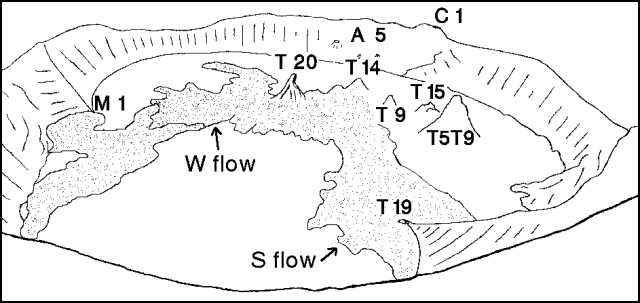Report on Ol Doinyo Lengai (Tanzania) — October 1992
Bulletin of the Global Volcanism Network, vol. 17, no. 10 (October 1992)
Managing Editor: Lindsay McClelland.
Ol Doinyo Lengai (Tanzania) Continued lava production
Please cite this report as:
Global Volcanism Program, 1992. Report on Ol Doinyo Lengai (Tanzania) (McClelland, L., ed.). Bulletin of the Global Volcanism Network, 17:10. Smithsonian Institution. https://doi.org/10.5479/si.GVP.BGVN199210-222120
Ol Doinyo Lengai
Tanzania
2.764°S, 35.914°E; summit elev. 2962 m
All times are local (unless otherwise noted)
When St. Lawrence Univ students visited the crater on 30 September, the T20 cone . . . was ~9 m tall, with lava flowing W from a crack ~12 m from its base (figure 26). Gurgling and rushing sounds from T20 were heard. The active lava flow was very quiet, ~15 cm wide, and diverged in many places. The lava flowing toward the W was darker than flows that were no longer active. The young S flow from T20 had a jagged surface, with large pieces pushed to the S wall of the crater. The surface of the E flow from T20 was smooth.
Geological Summary. The symmetrical Ol Doinyo Lengai is the only volcano known to have erupted carbonatite tephras and lavas in historical time. The prominent stratovolcano, known to the Maasai as "The Mountain of God," rises abruptly above the broad plain south of Lake Natron in the Gregory Rift Valley. The cone-building stage ended about 15,000 years ago and was followed by periodic ejection of natrocarbonatitic and nephelinite tephra during the Holocene. Historical eruptions have consisted of smaller tephra ejections and emission of numerous natrocarbonatitic lava flows on the floor of the summit crater and occasionally down the upper flanks. The depth and morphology of the northern crater have changed dramatically during the course of historical eruptions, ranging from steep crater walls about 200 m deep in the mid-20th century to shallow platforms mostly filling the crater. Long-term lava effusion in the summit crater beginning in 1983 had by the turn of the century mostly filled the northern crater; by late 1998 lava had begun overflowing the crater rim.
Information Contacts: N. Patridge, NH; C. Nyamweru, St. Lawrence Univ.


